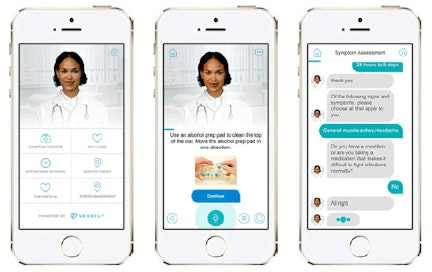Perspectives

From time spent at digital health conferences recently – such as CES, SXSW, Exponential Medicine, ConnectedHealth and Health 2.0. – I’ve learned that it’s not the introduction of a ‘new digital health trend’ that’s impacting pharma manufacturers but rather the maturity and evolution of several existing trends. Technological advancements enable digital health trends to have more widespread applicability. Three prominent trends – artificial intelligence, voice assistants and virtual/telehealth – have significant influence on pharmaceutical manufacturers and marketers.
ARTIFICIAL INTELLIGENCE
I like to think of AI as ‘automation on steroids’. There are two forms of AI that have been more widely adopted and used in healthcare. Cognitive algorithms enable computers to learn from the data and results that are generated over time. Known as machine learning, it can be applied to augment and accelerate human tasks. The second is a form of technology that understands written, or verbal, unstructured human language – better known as natural language processing (NLP) or natural language generation (NLG).
Machine learning and NLP are positively impacting the research being conducted by pharma companies. Market researchers view AI as a gamechanger for analyzing unstructured data, understanding emotion, or identifying trends that are hidden to the human eye. Machine learning in clinical trial research is being used to reduce the average time to find and recruit patients to clinical trials from months to minutes. This has a huge impact on closing the gap of $5.9m needed annually for clinical research. Deep 6 AI is a leading company applying this form of AI to fragmented medical documents to match complex clinical trial criteria in the physician’s office and at the point of care.
VOICE ASSISTANTS
Many of us own, or are familiar with, Amazon Alexa and Google Home. These are AI devices that understand or process natural language, as well as generate natural language responses. Increasingly, these devices are being adopted by healthcare providers and patients to ask clinical questions or seek disease information. The Merck-sponsored Alexa Diabetes Challenge focused innovators on creating voice-enabled solutions to improve the lives of those with Type 2 diabetes. Amazon Echo Spot and Show screen-enabled devices are now tools for incident tracking and appointment reminders.

Moreover, the advancements in voice assistants provide personal and conversational interactions to improve medication adherence. Sensely’s customised platform uses voice recognition, NLG and avatar technology to create an interactive virtual nurse assistant. Companies like Novartis and Bayer, as well as research centers like the Mayo Clinic, are using Sensely to help clinicians and patients better manage and monitor their health.
VIRTUAL/TELEHEALTH
Technology can eliminate the physical roadblocks that are typically barriers for populations to receive healthcare. Advances in interoperability and biometric sensors are improving the accuracy of data collected and exchanged between patient and healthcare professionals, consequently making telemedicine a more effective option for populations.
Imagine a world of ‘healthcare without walls’. Well, companies like pingmd and Doctor On Demand are doing it, connecting doctors to people and providing interconnected platforms across the care continuum. Medically Home enables you to admit yourself to your home hospital! Hospital-level care such as infusion, physical therapy and clinical services can all be arranged and managed at home. Connecting doctors to people and enacting behavioural change is at the heart of virtual health or telemedicine. As an industry we’re still not there yet with regard to payment parity, but we’re making great strides.
Virtual health, and the ability to manage chronic disease, is further enabled by the improvements in biometric sensors. The latest mobile device sensors and other IoT chip technology bring remarkable clinical setting precision to the home, transforming smartphones into a medical device. For example, FibriCheck is a medically certified and reimbursed AI app. By placing your finger over your phone camera, it can detect irregular heart rhythms, anywhere and anytime, and share this information with your healthcare provider. FibriCheck has proven outcomes to preventing strokes and was recognised by J&J Innovation Labs as the winner for the Mobile Wellness Management Challenge. For pharma, companion digital therapeutics such as this become a holistic part of the therapy regiment in addition to a prescribed drug.
DON’T FORGET THE PERSON
One resounding takeaway from all of our digital conferences was that digital cannot be a substitute for real-life interactions. It’s easy to get lost in the bling of technology or the buzzwords of AI and big data. However, there are significant implications to healthcare companies when bridging the virtual and real worlds. Much like doctors need to humanize patients versus seeing the ‘films’ of a patient, the innovators of digital health platforms also need to see the patients and not just the devices we’re enabling.
This hit home when listening to Tara Narula MD at a digital health conference last year. She commented, “Fear and insecurity come with being a patient, so we need to have empathy. Medicine is personal. Behind every screen is a human patient and a life story.” Let’s not forget it.
Sources: OHG Digital Picks 2018; SXSW 2018; Greenbrook Research Industry Trends Report Q3-Q4 2017; Fierce Pharma Aug 21, 2017








